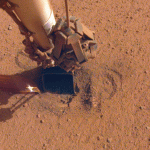
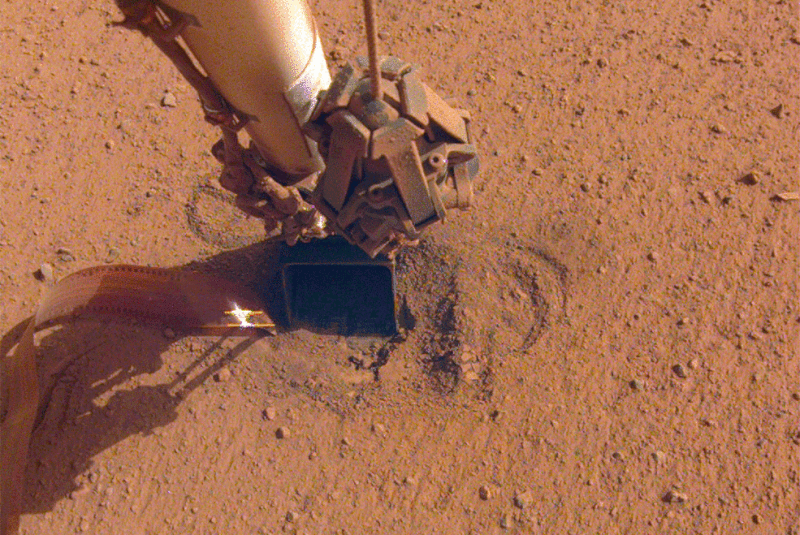
Here’s the NASA’s InSight lander’s heat probe – nicknamed “the mole” – on October 3, 2020, when the spike-like mole was still trying to burrow into the red Martian soil. The copper-colored ribbon attached to the mole has sensors to measure the planet’s heat flow. Now NASA engineers have called a halt to this part of the mission. Image via NASA/ JPL-Caltech.
One key aspect of NASA’s InSight mission on Mars sadly came to an end last week. NASA announced that InSight’s HP3 heat probe – aka the mole – hasn’t been able to gain the friction it needs to dig as deeply as planned into Mars’ surface. Now mission engineers have finally ended attempts, NASA said, to get the probe to burrow deeper into the soil. However, there’s also good news. The mission has been granted an extension, giving it more time on Mars’ surface to carry out its other tasks.
The mole – known officially as the Heat Flow and Physical Properties Package – was designed to dig down as far as 16 feet (5 meters). The goal was to take measurements of the internal temperature of Mars, providing vital clues as to how geologically active Mars still is and how much heat it still retains in its interior.
The problem was that the mole required friction from the surrounding soil to be able to continue digging deeper. As it turns out, the soil on that part of Mars was more clumpy than had been expected, meaning less friction. The mole would penetrate a couple of centimeters or so,less than an inch, and then it would tend to pop back up again. Eventually, the mission team started trying to push the mole farther down with the scoop on the lander’s robotic arm. Soil would be scraped onto the mole, and then the scoop would be used to tamp it down with “hammering strokes,” hopefully providing more friction. That worked to some degree, for a while, but still wasn’t enough to get the mole to continue digging deeper on its own.
By January 9, 2021, over 500 such hammering strokes had been conducted, to no avail. At that point, the mission team called an end to the effort.
It’s unfortunate, but – as you can imagine – unexpected problems often arise when exploring worlds that are hundreds of millions of miles away. As Tilman Spohn of German Aerospace Center (DLR), which built the mole, stated:
We’ve given it everything we’ve got, but Mars and our heroic mole remain incompatible. Fortunately, we’ve learned a lot that will benefit future missions that attempt to dig into the subsurface.

The mission team used the scoop at the end of the robotic arm to try to hammer the heat probe deeper down into the soil. The attempts were unsuccessful, however, because of the lack of friction in the soil due to clumpiness. Image via NASA/ JPL-Caltech.
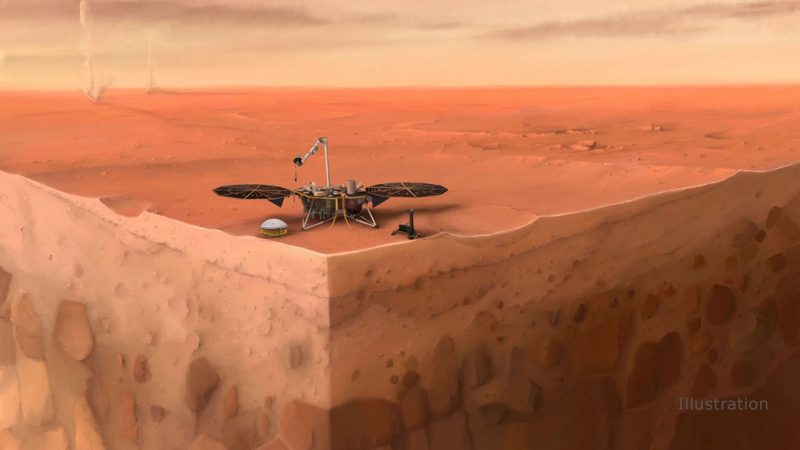
Artist’s concept of NASA’s InSight lander on Mars, with a cutaway view of the subsurface. Image via PGP/ Nicolas Sarter/ JPL-Caltech.
Other landers and rovers have used scoops to dig into the surface layers of soil to obtain samples, but InSight’s mole was meant to burrow down significantly deeper. The failure to dig deep enough is disappointing, but it certainly wasn’t for lack of trying, and is still a success in other ways. As Thomas Zurbuchen, associate administrator for science at NASA, said:
We are so proud of our team who worked hard to get InSight’s mole deeper into the planet. It was amazing to see them troubleshoot from millions of miles away. This is why we take risks at NASA, we have to push the limits of technology to learn what works and what doesn’t. In that sense, we’ve been successful: We’ve learned a lot that will benefit future missions to Mars and elsewhere, and we thank our German partners from DLR for providing this instrument and for their collaboration.
So what went wrong?
The clumpiness of the soil was surprising, since testing of the instrument back on Earth was based on properties of the Martian soil seen by previous missions to Mars. But the soil at InSight’s landing site, in Elysium Planitia, proved to be different from that seen at any other landing site. According to Troy Hudson, a scientist and engineer at NASA’s Jet Propulsion Laboratory (JPL):
The mole is a device with no heritage. What we attempted to do – to dig so deep with a device so small – is unprecedented. Having had the opportunity to take this all the way to the end is the greatest reward.
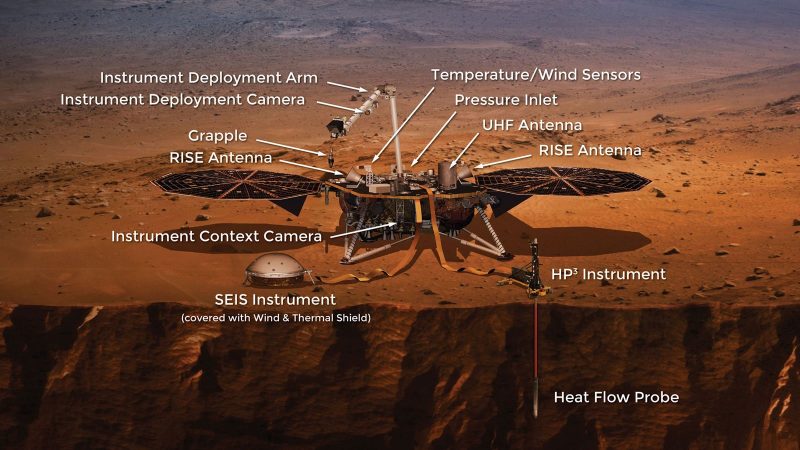
InSight has many different scientific instruments. The heat flow probe, shown on the right, was supposed to burrow down about 16 feet (five meters) into the ground. Image via NASA/ JPL-Caltech.
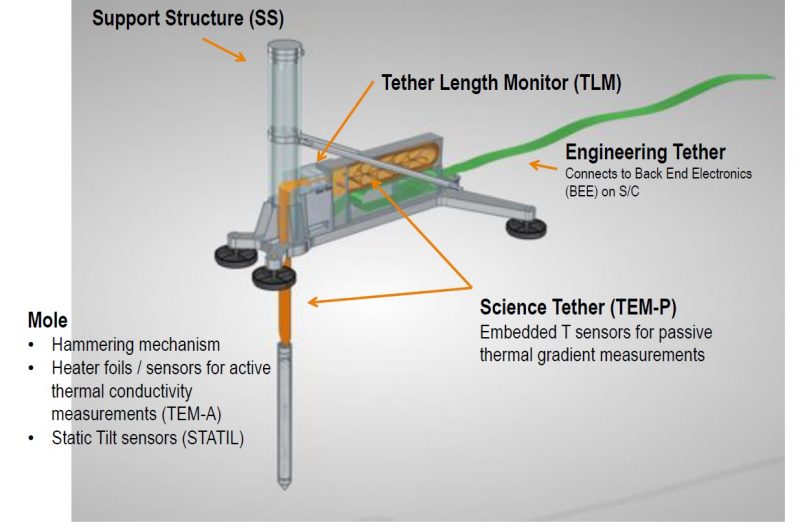
Diagram of the heat flow probe. Image via DLR/ InSight Project/ Spaceflight 101.com.
All is not lost, however. The setback provided the mission team with more experience using the robotic arm as well as the chance to learn more about the soil at this location. What makes it more clumpy?
Another task in the near future will be to use the robotic arm to bury the tether that connects the seismometer instrument – called the Seismic Experiment for Interior Structure (SEIS) – to the lander. It is hoped that doing so will reduce the amount of cracking and popping sounds heard in the seismic data due to temperature changes.
SEIS takes the “pulse” of Mars, listening for seismic activity below the surface, and has recorded over 480 marsquakes so far. By far most are very small, but they tell scientists how active Mars is below the surface. So far, it seems to be somewhere between the Earth and moon. Some of the seismic activity detected by InSight has come from regions with still-active faults and ancient volcanoes, suggesting that Mars may still be volcanically active to some degree, at least below the surface.
The lander itself continues to be in overall excellent health, which is good news, and the mission has been extended another two years, until December 2022. That means there is still a lot more science that can be done with all of InSight’s other instruments.
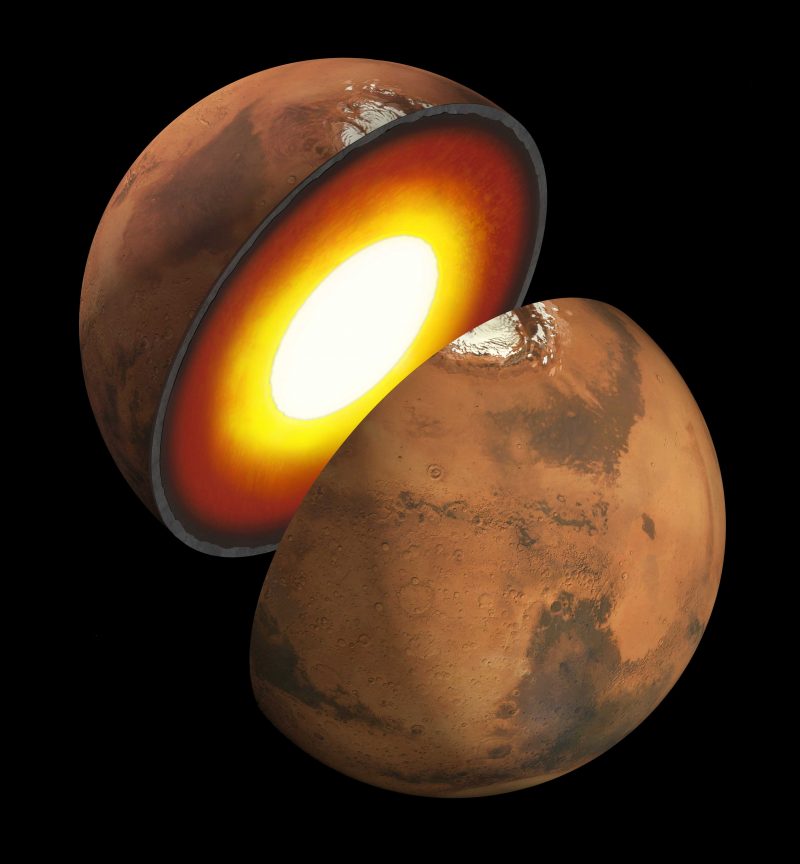
InSight’s mission is primarily to study the interior of Mars and determine if the planet is still geologically active. Image via NASA/ JPL-Caltech.
InSight’s overall mission is to study the interior of Mars, to determine how geologically active the planet still is, and how it formed and has changed over the past several billion years. A radio experiment onboard called Rotation and Interior Structure Experiment (RISE) is designed to find out if Mars’ core is still liquid or if it is solid, and what its overall composition is, including iron.
InSight also monitors Martian weather above the surface, with some of the most advanced weather sensors ever sent to the planet. The Curiosity rover also monitors the atmosphere and weather, as will the Perseverance rover when it lands next month, on February 18. All three together will create the first meteorological network on another planet, another huge accomplishment.
The mole may not be digging anymore, but the mission is far from over, with a lot of good science still to come!
Bottom line: The mission team for NASA’s InSight lander on Mars has called off any further attempts to try to dig deep into the soil with the heat probe instrument called “the mole.” The rest of the mission continues, however, with an extension to December 2022.
from EarthSky https://ift.tt/3c7Yto6


Here’s the NASA’s InSight lander’s heat probe – nicknamed “the mole” – on October 3, 2020, when the spike-like mole was still trying to burrow into the red Martian soil. The copper-colored ribbon attached to the mole has sensors to measure the planet’s heat flow. Now NASA engineers have called a halt to this part of the mission. Image via NASA/ JPL-Caltech.
One key aspect of NASA’s InSight mission on Mars sadly came to an end last week. NASA announced that InSight’s HP3 heat probe – aka the mole – hasn’t been able to gain the friction it needs to dig as deeply as planned into Mars’ surface. Now mission engineers have finally ended attempts, NASA said, to get the probe to burrow deeper into the soil. However, there’s also good news. The mission has been granted an extension, giving it more time on Mars’ surface to carry out its other tasks.
The mole – known officially as the Heat Flow and Physical Properties Package – was designed to dig down as far as 16 feet (5 meters). The goal was to take measurements of the internal temperature of Mars, providing vital clues as to how geologically active Mars still is and how much heat it still retains in its interior.
The problem was that the mole required friction from the surrounding soil to be able to continue digging deeper. As it turns out, the soil on that part of Mars was more clumpy than had been expected, meaning less friction. The mole would penetrate a couple of centimeters or so,less than an inch, and then it would tend to pop back up again. Eventually, the mission team started trying to push the mole farther down with the scoop on the lander’s robotic arm. Soil would be scraped onto the mole, and then the scoop would be used to tamp it down with “hammering strokes,” hopefully providing more friction. That worked to some degree, for a while, but still wasn’t enough to get the mole to continue digging deeper on its own.
By January 9, 2021, over 500 such hammering strokes had been conducted, to no avail. At that point, the mission team called an end to the effort.
It’s unfortunate, but – as you can imagine – unexpected problems often arise when exploring worlds that are hundreds of millions of miles away. As Tilman Spohn of German Aerospace Center (DLR), which built the mole, stated:
We’ve given it everything we’ve got, but Mars and our heroic mole remain incompatible. Fortunately, we’ve learned a lot that will benefit future missions that attempt to dig into the subsurface.

The mission team used the scoop at the end of the robotic arm to try to hammer the heat probe deeper down into the soil. The attempts were unsuccessful, however, because of the lack of friction in the soil due to clumpiness. Image via NASA/ JPL-Caltech.

Artist’s concept of NASA’s InSight lander on Mars, with a cutaway view of the subsurface. Image via PGP/ Nicolas Sarter/ JPL-Caltech.
Other landers and rovers have used scoops to dig into the surface layers of soil to obtain samples, but InSight’s mole was meant to burrow down significantly deeper. The failure to dig deep enough is disappointing, but it certainly wasn’t for lack of trying, and is still a success in other ways. As Thomas Zurbuchen, associate administrator for science at NASA, said:
We are so proud of our team who worked hard to get InSight’s mole deeper into the planet. It was amazing to see them troubleshoot from millions of miles away. This is why we take risks at NASA, we have to push the limits of technology to learn what works and what doesn’t. In that sense, we’ve been successful: We’ve learned a lot that will benefit future missions to Mars and elsewhere, and we thank our German partners from DLR for providing this instrument and for their collaboration.
So what went wrong?
The clumpiness of the soil was surprising, since testing of the instrument back on Earth was based on properties of the Martian soil seen by previous missions to Mars. But the soil at InSight’s landing site, in Elysium Planitia, proved to be different from that seen at any other landing site. According to Troy Hudson, a scientist and engineer at NASA’s Jet Propulsion Laboratory (JPL):
The mole is a device with no heritage. What we attempted to do – to dig so deep with a device so small – is unprecedented. Having had the opportunity to take this all the way to the end is the greatest reward.

InSight has many different scientific instruments. The heat flow probe, shown on the right, was supposed to burrow down about 16 feet (five meters) into the ground. Image via NASA/ JPL-Caltech.

Diagram of the heat flow probe. Image via DLR/ InSight Project/ Spaceflight 101.com.
All is not lost, however. The setback provided the mission team with more experience using the robotic arm as well as the chance to learn more about the soil at this location. What makes it more clumpy?
Another task in the near future will be to use the robotic arm to bury the tether that connects the seismometer instrument – called the Seismic Experiment for Interior Structure (SEIS) – to the lander. It is hoped that doing so will reduce the amount of cracking and popping sounds heard in the seismic data due to temperature changes.
SEIS takes the “pulse” of Mars, listening for seismic activity below the surface, and has recorded over 480 marsquakes so far. By far most are very small, but they tell scientists how active Mars is below the surface. So far, it seems to be somewhere between the Earth and moon. Some of the seismic activity detected by InSight has come from regions with still-active faults and ancient volcanoes, suggesting that Mars may still be volcanically active to some degree, at least below the surface.
The lander itself continues to be in overall excellent health, which is good news, and the mission has been extended another two years, until December 2022. That means there is still a lot more science that can be done with all of InSight’s other instruments.

InSight’s mission is primarily to study the interior of Mars and determine if the planet is still geologically active. Image via NASA/ JPL-Caltech.
InSight’s overall mission is to study the interior of Mars, to determine how geologically active the planet still is, and how it formed and has changed over the past several billion years. A radio experiment onboard called Rotation and Interior Structure Experiment (RISE) is designed to find out if Mars’ core is still liquid or if it is solid, and what its overall composition is, including iron.
InSight also monitors Martian weather above the surface, with some of the most advanced weather sensors ever sent to the planet. The Curiosity rover also monitors the atmosphere and weather, as will the Perseverance rover when it lands next month, on February 18. All three together will create the first meteorological network on another planet, another huge accomplishment.
The mole may not be digging anymore, but the mission is far from over, with a lot of good science still to come!
Bottom line: The mission team for NASA’s InSight lander on Mars has called off any further attempts to try to dig deep into the soil with the heat probe instrument called “the mole.” The rest of the mission continues, however, with an extension to December 2022.
from EarthSky https://ift.tt/3c7Yto6

Aucun commentaire:
Enregistrer un commentaire